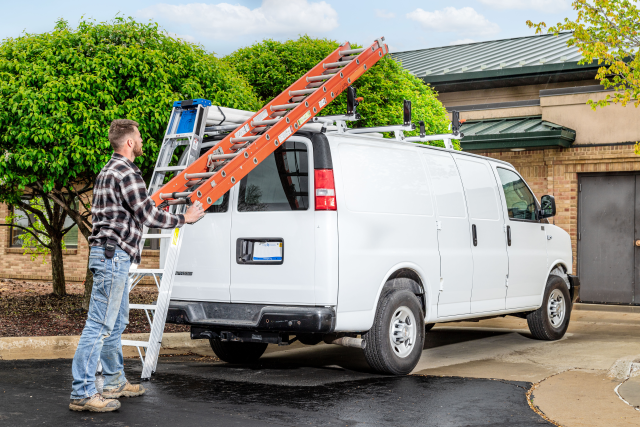Upfits are an important investment: A well‐executed upfit improves productivity, safety, ergonomics, and employee satisfaction. A poorly planned upfit can waste both your time and your money.
How do you ensure your upfit is a success? Adrian Steel’s Adam Gregory, Sales Engineering Manager, and Katie Groves, National Fleet Sales Manager, share five tips to make the most of your upfit investment.
Tip #1: Take a Big‐Picture Approach to the Order Cycle
When ordering and upfitting new vehicles, fleet managers have an idea of what they want and when they want it. But there are a lot of moving parts between ordering a vehicle and putting it on the road that can derail their plan.
“One of the toughest challenges fleet managers face today is creating and maintaining a realistic, comprehensive fleet plan,” Groves said. “It’s important for fleet managers to understand how their decisions affect their overall timeline, which ultimately impacts the delivery of their vehicles.”
Each decision made — especially changes made midstream — can affect the overall timeline and delay vehicle delivery, so Groves says taking time to establish the “what” of the order can ensure the ideal “when” can be achieved.
It’s also important to keep in mind that your fleet isn’t the only party involved: the OEM, the upfitter, and sometimes a fleet management company all have their own set of tasks and priorities, so taking a step back and understanding all of the steps required before placing the order is critical to develop a realistic timeline.
“It is imperative that fleet managers have strong partners that understand the entire value stream,” Groves said. “Adrian Steel Company works with our fleet customers to build an annual plan one year to 18 months ahead of vehicle delivery. This approach sets the fleet order cycle up for successful implementation by ensuring the OEM, the fleet management company, the upfitter, and the customer are all on the same page.”
Tip #2: Align Fleet and Field Needs with a Site Visit
Just as OEMs, upfitters, and fleets all play a role in a successful upfit, oftentimes multiple stakeholders within a fleet are involved in an order. When these parties have conflicting goals, it can jeopardize an upfit.
“Many times, it is procurement, and not operations, that places the equipment order for the upfit to be installed in a fleet vehicle,” said Adam Gregory, Sales Engineering Manager. “While procurement negotiates the price, operations is the team that ultimately uses the vehicle equipped with the cargo management solution.”
To ensure the goals of those placing the orders meet the needs of the end user, Gregory suggests those responsible for ordering see first‐hand how the truck or van is used and what drivers need out of the vehicle and the upfit.
“Participating in a ride along and/or a site/field visit will help fleet managers obtain a better understanding of what is happening in the field,” Gregory said. “Ride alongs and site visits are a standard part of our process at Adrian Steel Company, so that we can understand our customers’ business and operations needs and bring the greatest value as a strategic upfitter and supplier.”
Tip #3: Get Help Navigating Supply Chain Challenges
Just like everything else these days, upfits are susceptible to supply chain disruptions. Whether it’s vehicle availability or unreliable delivery times, fleets need to anticipate these hiccups. Katie Groves said having a partner with the expertise to help anticipate and navigate potential disruptions can help create a realistic — but successful — timeline.
“Supply chain reliability is a problem most industries are facing today,” Groves said. “Adrian Steel works to get in front of those issues and help fleets navigate them. As their one‐stop shop for the upfit solution, we articulate risk when it arises and make sound recommendations to the customer to assist with timely decision‐making in order to give the customer the best chance of maintaining their timeline.”
Tip #4: Make a Plan for Onboarding and Training
Once your new units arrive, Adam Gregory warns against sending them out to the field without proper introduction to their users.
“Onboarding and training are an important part of a successful upfit,” he said. “Technicians need to know how to navigate their new workspace to stay safe and maximize productivity.”
Beyond keeping drivers safe and making the most of their new upfits, Gregory said taking time to orient drivers with the features and benefits can help fleets retain technicians.
“Showing employees that you’ve invested in their comfort and safety demonstrates you care. And making it easier for them to do their jobs improves their satisfaction,” Gregory said. “This ultimately results in a happier workforce, which means a more productive workforce.”
Tip #5: Measure Past Performance to Fuel Future Success
Measuring the success of your upfit can help you make the next one even more successful. However, it’s important to do so in a consistent manner in order to work from the best data.
“Measuring the success of a fleet is a major challenge for any company,” Adam Gregory said. “Many companies measure success or savings year‐over‐year, but that is an incomplete picture.”
Gregory suggests asking the following questions to accurately measure success:
- How much did you spend on repairs?
- Has the new cargo management solution saved technicians time by reducing the number of hours they work?
- How many fewer injuries are there on the job with the new solution compared to the old one?
It’s the operational TCO that ought to be considered when measuring a successful solution —not just the upfront spend.
“The key to measuring success is to create a plan to measure at the time at which the improvement is made,” Gregory said. “Plan, do, check, act is an important principle and if not applied, a fleet manager can miss out on reporting valuable savings to their organization.”
Planning an Upfit?
To learn more about how to execute a successful upfit plan, contact Adrian Steel.
Sponsored by 
Source: https://www.automotive-fleet.com





